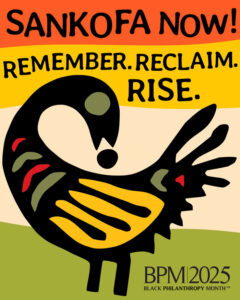In 2011, Dr. Jackie Copeland founded Black Philanthropy Month as a time to recognize Black-led change in communities and elevate the donor power of Black individuals and majority-Black institutions. Black Philanthropy Month (BPM) continues today, and this year’s theme for BPM is Sankofa Now: Remember, Reclaim, Rise.
We sat down with Karen Ford, CEO of HousingPlus, to discuss her experience and perspective on this year’s BPM topic.
Remember
Karen began by reflecting on how her personal history impacts her work as a Black female leader of a nonprofit that serves a majority BIPOC client base.
“My mom fled the segregated South. By the time she was 37 years old, she had nine children,” says Karen, “My mom experienced abuse and alcoholism at the hands of her husband. She became a single mother. As one of nine, I was a product of the safety net system.”
Karen adds, “There was a Boys and Girls Club across the street, there was a church around the corner where I went to summer camp, and the Fresh Air Fund took us on trips outside of the city and helped me expand my thinking beyond the ten blocks where I lived. When I started to go astray as a young adult, there was an alternative to incarceration program that gave me a second chance. Those are lenses through which I view the work I’m doing today, and I’ve dedicated my entire life to serving communities because I saw how my community shaped me.”

“The people are never the problem. Racist institutions and systems created the need for social support in majority-Black communities.”
Reclaim
Karen has worked in public service for more than 30 years; however, she says, “It’s really within the last 10-15 years that I have seen an intentional effort by boards of directors, executive search firms, and philanthropic efforts to cultivate and create space for Black leadership in preparation to lead.”
She continues, “The shift is in the recognition and acknowledgement that oppressive and racist systems and structures perpetuate Black people being excluded. The people are never the problem. Black people are not the problem: institutions and systems created the need for social support in these majority-Black communities, which in turn gave rise to the perception that the people are the problem. ”
Systemic racism can impact our perception of Black leaders in nonprofits, says Karen, “Sometimes Black people are not trusted to lead. They are viewed as recipients of rather than custodians and deliverers of services.”
People of color organize and lead many grassroots nonprofits, Karen notes, but they are less able to access large funding streams. “These are people leading from the heart, and they are the ones serving a meal to a child after school or helping build a community garden,” she says.
“I’ve dedicated my entire life to serving communities because I saw how my community shaped me.”
Rise
When Karen thinks about helping people rise and people raising themselves, she thinks of Housing First. “In our model, we center permanent housing,” she says, “Giving a woman stability first, and then providing wraparound services that allow her and her family to thrive.”
Housing stability is an important part of Karen’s family story as well: “We had public housing. That was one thing my mother did not have to worry about. And all around that housing were community supports that were so valuable.”
Karen identified three primary things that I believe funders, individuals, and donors can do to “rise to the occasion to invest in Black leaders and Black communities and a future for all nonprofits”:

- Understand and educate themselves about implicit bias: “Everything starts with how you see things,” says Karen.
- Recognize the devastating impact that systemic racism has had on the destruction of Black families and communities. “Housing is a huge part of this,” says Karen, “Your zip code where you live determines outcomes a great deal.”
- Commit to antiracist practices to guide philanthropic giving. Karen adds, “Look for barriers and double standards in requirements for grant seekers. Some philanthropic funds have removed all the barriers that have existed, and we need more of that.”
